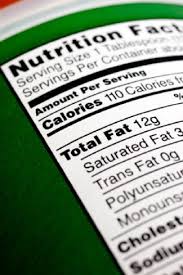
Food label terms fall into a few categories, like those aimed at weight loss, those for people concerned with heart health and those related to health in general. Of course, in many cases, the categories overlap. If weight loss or maintenance is your concern you’re probably drawn to terms like reduced calorie, reduced fat, low fat, low calorie or light (or lite).
Here’s what these terms actually mean:
To qualify as reduced calorie a food must have at least 25 percent fewer calories than the regular version of the same food. So, reduced calorie does not necessarily mean low calorie.
For instance, the original food has 440 calories per serving and the reduced calorie version may have 330 calories, which is indeed reduced but still not reduced enough to make a meaningful difference. And what does one serving mean? Is it enough to satisfy the average person? To find out you need to read the label.
The term reduced fat works the same way. Food that is labeled “reduced fat” must have at least 25 percent less fat than the regular version. Low fat means no more than 3 grams of fat per serving. Very often reduced fat food has high sugar levels to give the food flavour.Low fat yoghurt especially has this issue!
Low calorie means no more than 40 calories per serving, and to be classified as light/lite, a food must have either one third fewer calories or half the fat of the regular version. But again, how big is a serving? As you can see, you really need to ask yourself questions about what is not necessarily obvious to really understand the terms on food labels.
People concerned with heart health look at label terms like fat free, cholesterol free, low saturated fat and lean. Fat free means there are less than 0.5 grams per serving.
Cholesterol free refers to foods with 2 or fewer milligrams of cholesterol and 2 grams or less of saturated fat per serving.
The amusing thing with this claim is that it is sometimes used on products like fruit drinks – mostly sugar – that never had cholesterol to begin with! Other heart healthy claims like the term low saturated fat means there is a gram or less of saturated fat in a serving of the food and lean foods (usually meats) are foods with 10 or fewer total fat grams per serving. Low cholesterol foods can have no more than 20 milligrams of cholesterol per serving.
Other interesting food label terms designed to attract health conscious consumers include fresh, healthy and natural flavors.
Interestingly, a food labeled healthy must have a number of qualifications. It cannot have more than a gram of saturated fat and 3 grams of total fat per serving. Additionally, there must be at least 10 percent of the recommended daily amount of vitamin A, vitamin C, calcium, iron, protein and fiber.
Sodium(salt) foods that are labeled as healthy are limited to 300 milligrams, unless we’re talking about a pre-packaged meal, which can have up to 480 milligrams of sodium and still be considered healthy.
Believe it or not, a food labeled healthy can have as much sugar as the manufacturer cares to add! This can really be a problem because many people will buy a “low fat” food like yogurt without realizing how high the sugar content can be. If you want to know how much sugar you are getting, look at the food label to find the total number of grams of carbohydrates. Under that number, you’ll see how many of those carbohydrate grams are from sugars. If the number of grams of sugar is too close to the total number of carbohydrates (meaning most of the carbohydrate grams are from sugar), the less likely it is that you are eating a truly healthy food.
To be truly healthy, most of your carbs should come from nutrient-rich complex carbs – the kind that do not push your blood sugar level into overdrive.
The claims go on as do the endorsements from organizations like the American Heart Association (AHA) and the American Cancer Society (ACS). Though it’s easy to trust a product that has a big red heart on it to indicate that the product meets the guidelines of the AHA, the endorsement may not mean much; the official guidelines of both the AHA and the ACS are considered extremely lenient by many nutritionists.
For example, the AHA never mentions the dangers of hydrogenated fats in its guidelines. It also allows 30 percent of total calories from fat, an amount that is probably too high, especially for people who have already been victims of heart disease (and the ones most likely to pay attention to those labels).
That’s all for now, but before we go we would like to tell you what’s coming. The truth about enriched foods. Enriched sounds good but… Is it “enriched” equal to better? You’ll find out soon.
Wishing you good health and happiness !